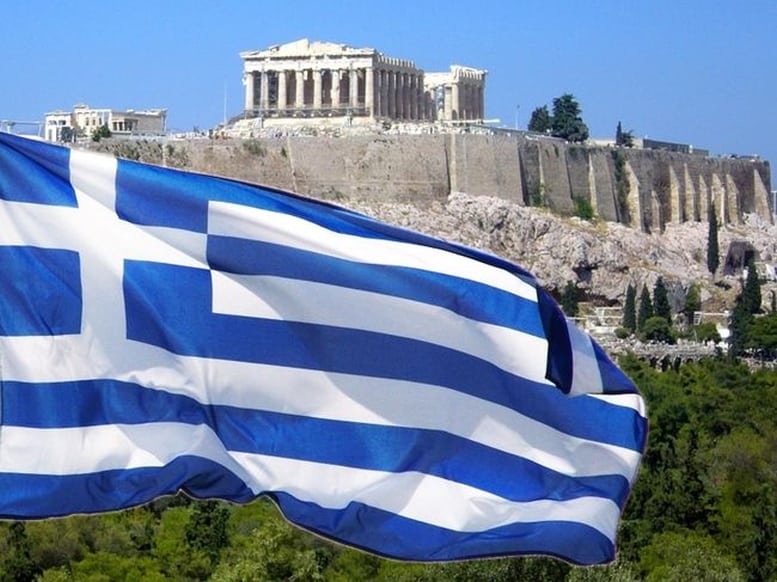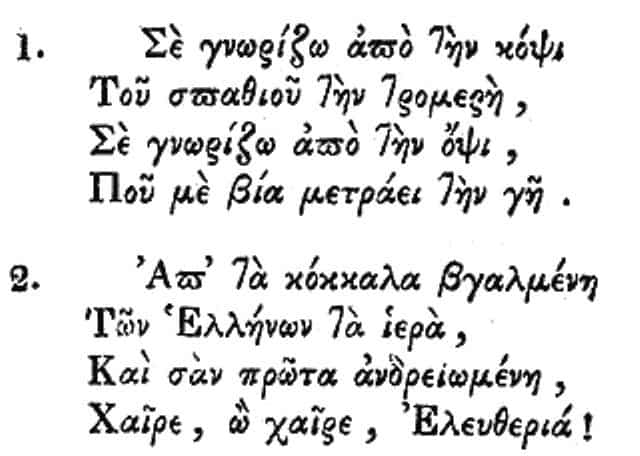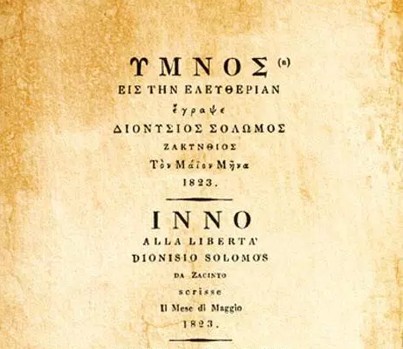On the occasion of the National Day of Greece, where the country celebrates the anniversary of its War of Independence against the Ottoman Turks, Greek City Times presents some interesting facts about the three national symbols of the Greek nation: its flag, its emblem and its anthem.
THE NATIONAL FLAG OF GREECE
The national flag of Greece consists of nine horizontal stripes of equal width, five blue and four white, alternately, the first and last stripes being blue. The upper left corner contains a blue square, along the five stripes with a white cross inside it. The flag is hung on a white flagstaff at the top of which there is a white cross.

On the occasion of the National Day of Greece, where the country celebrates the anniversary of its War of Independence against the Ottoman Turks, Greek City Times presents some interesting facts about the three national symbols of the Greek nation: its flag, its emblem and its anthem.
THE NATIONAL FLAG OF GREECE
The national flag of Greece consists of nine horizontal stripes of equal width, five blue and four white, alternately, the first and last stripes being blue. The upper left corner contains a blue square, along the five stripes with a white cross inside it. The flag is hung on a white flagstaff at the top of which there is a white cross.
HISTORY
The land flag used to be square in shape, and used to have a white cross on a blue background. The marine flags resembled the current national flag. The only difference in the flag of the merchant marine was the reversal of colours in the corner where the cross was (a blue cross on a white background). The flag of the merchant ships was ranked with that of the navy in 1828, when it was recognised that merchant ships had taken part in the war of independence as war-ships.
The national flag has been modified several times since then, mainly as a result of regime changes, without being radically altered. In 1833 the Bavarian coat of arms was added to the flags of the army and the navy and remained until the overthrow of King Otto in October of 1862. With the arrival of King George I in 1863 the crown was introduced into the flags of the above forces and remained there until the regime change in 1924.
From 1864 onwards the flag of the infantry regiments was made of silk with a gold fringe all round and had a picture of their patron saint, Saint George, in the centre of the white cross.
THE FLAG TODAY
The war flags currently are: for the navy, the national flag and, for the army and the air force, a rectangular flag consisting of a white cross on a blue background, the cross dividing the flag into four equal parts. In the centre of the cross, the flag of the army bears a picture of Saint George, while the flag of the air force bears a picture of the Archangel Michael.

THE EMBLEM OF THE HELLENIC REPUBLIC
The national emblem of Greece consists of a blue escutcheon with a white cross totally surrounded by two laurel branches.
The emblem is painted or woven, mainly on the hats, uniforms and buttons of the military, the security forces etc.
The Greek national emblem was provided for by the Constitution of Epidaurus on January 1, 1822 and was established by decree on 15 March of the same year. It was blue and white and circular in shape.
HISTORY
Since it was first established, the emblem has undergone many changes in shape and design, mainly due to changes of regime.
The original Greek national emblem depicted the goddess Athena and the owl. At the time of Kapodistrias, the first Prime Minister of modern Greece, the phoenix, the symbol of rebirth, was added. During the reign of King Otto, the royal crest, with two crowned lions holding the coat of arms with the royal crown, became the national emblem of the country. With the arrival of King George I, the Bavarian emblem was replaced by the Danish one. After Greece became a republic in 1924 the national emblem used to consist of a simple white cross on a blue background. The Danish emblem returned with the restoration of Monarchy until 1967.
NATIONAL ANTHEM
The National Anthem of Greece consists of the first two verses of the poem “Hymn to Freedom”, written in May 1823 in Zakynthos by the poet Dionysios Solomos. A year later it was published in Mesolonghi and the same year Fauriel included it in a collection of Greek folk songs. In 1828 Nicholas Mantzaros, a Corfiot musician and friend of Solomos’ set the poem to music, based on a folk theme, intended for a four-voice male choir rather than preserving its character of march. After that the “Hymn to Freedom” was regularly heard on national holidays.
HISTORY
In 1844 the poem was once again set to music by Mantzaros and submitted to King Otto in the hope that he would accept it as the national anthem. In spite of N. Mantzaros being awarded the Silver Cross of the Order of the Redeemer and D. Solomos’ being awarded the Gold Cross of the same Order, the work was not ratified as the national anthem but became popular as a battle song.
In 1861 the Minister for the Military asked Mantzaros to compose a march based on the “Hymn to Freedom”. The musician altered the rhythm of Solomos’ hymn, giving it the rhythm of a march and in 1864, after the union of the Ionian Islands with Greece, the “Hymn to Freedom” was established as the national anthem. The national anthem, along with its music, was printed for the first time (27 copies) in London in 1873.

The poem “Hymn to Freedom” consists of 158 four-line verses of which the first 24 were established as the National Anthem in 1865. The first two of them are the ones usually played and accompany the raising and the lowering of the flag. During the playing of the national anthem one stands to attention.
*Source: presidency.gr

